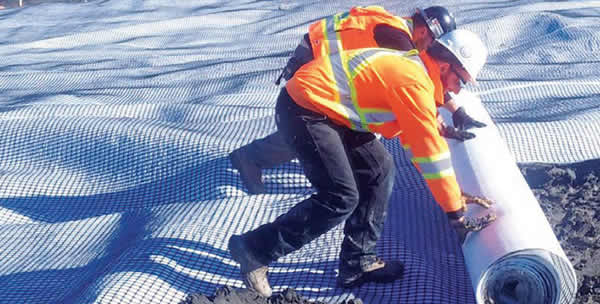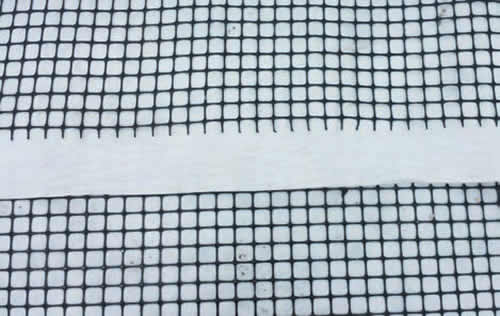Mines depend on consistent access for site safety, operational efficiency, and profitability. Delays in access can quickly cost active mines millions of dollars in lost production, and that can determine the fate of a site’s continued operation. In Northern Ontario, mine haul roads on composite geogrids have proven to be a highly effective strategy to keep mines running.

MINE HAUL ROADS – GEOTECHNICAL CHALLENGES
For the project site, the interface of the sub-base and the subgrade presented a concern. There, the presence of compacted clay with blast rock/granite base course meant that at the interface the unreinforced roads would be susceptible to lateral movement of particles under the heavy axle loads. This weakness would cause pumping and an upward movement of the subgrade fines. The sub-base could fail substantially. The repetitive heavy dump truck traffic also meant that heavy dynamic loads would be concentrated over this weak subgrade and result in higher differential settlement.
The mine haul roads needed to extend into a pit and provide passage for rock dump trucks weighing several hundred tonnes.
One solution was to use 1.0m of compacted crushed rock backfill (aggregate base) over the compacted clay subgrade. However, considering the characteristics of the subgrade soil on the site, engineers determined that both reinforcement and separation were important for optimal road performance.
A composite geogrid from Titan (TE-BXC40) was specified by engineers for the mine haul roads to be installed at the bottom of the aggregate base layer.

Reinforcement geogrid + durable soil separation with the geotextile. TE-BXC40 is a biaxial geogrid bonded to a 200 gsm continuous filament nonwoven geotextile by a precision heat bonding process.
WHY THE COMPOSITE GEOGRID WORKS
TE-BXC40 is a biaxial geogrid bonded to a 200 gsm continuous filament nonwoven geotextile by a precision heat bonding process. The geogrid acts as reinforcement while the geotextile works as a soil separator and filter to prevent contamination of the aggregate base by fines from the subgrade. This allows for better drainage of the sub-base, which helps maintain the soil structure stability.
In addition to its effective soil reinforcement, drainage, and filtration functions, the composite geogrid used in Northern Ontario generally allows for a thinner aggregate base. Placement and compaction works are more efficient and simpler. Furthermore, the composite design minimizes the loss of aggregate into the soft subgrade during construction and prevents penetration of individual aggregate particles into the soft subgrade under repeated traffic loads.
For mine haul roads, these geotechnical advantages can provide the functional security to keep operations running and profitable.
The use of a composite geogrid solution to improve the mine haul roads in on the site provided significant cost savings. The client used significantly less aggregate in the base (0.7 mm thick vs. 1.0 mm). This also helped reduce the carbon footprint of the construction works.
SOLUTION TAKEAWAYS
The use of the TE-BXC40 for the mine haul roads provided high tensile stiffness at low strains to resist construction damage, environmental exposure.
This type of geogrid product is ideal for combined soil stabilization/reinforcement applications. The geogrid enhances the structural performance of pavement systems by increasing the Layer Coefficient Ratio (LCR), while the nonwoven geotextile effectively keeps expensive, imported material from being contaminated by the migration of fines from the saturated base soils.
Titan’s composite geogrid is engineered to be mechanically and chemically stable in aggressive soil environments, and formulated to resist UV degradation. It is also not susceptible to hydrolysis, environmental stress cracking and micro-organism attack.
Learn more about Titan’s geogrids and global network at https://www.titanenviro.com. For inquiries please contact Titan’s Chief Technical Officer, Sam Bhat at: info@titanenviro.com or 1-204-878-3955 | 1-866-327-1957.











